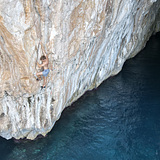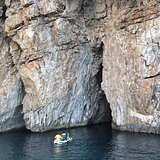The Karaburun Peninsula in the south of Albania. On its west side is a stretch of coastline full of steep rocky cliffs, caves and bays above the deep, blue ionian sea.
Although not far from some tourist hotspots that have seen a boom in development, it feels like a different world.
There are no roads, the only way to get to the bays is by a long, warm hike or a journey by boat.
During the day there might be some boats passing if it is peak season. If you stay the night, you're most likely to have a bay to yourself.
The area is full of potential still. The lines that have been climbed so far have only just started to explore the options, and we haven't reached halfway to the end of the peninsula yet.
SAFETY
Keep in mind that this is a wild, remote area in some ways. The water is blue and welcomingly warm during summer, the rock is mostly of great quality and on most established lines the landing is straightforward and deep. This doesn't change the fact that you will be out on the sea in a place with limited cell reception and no freshwater sources. This can add to the experience, but make sure to plan accordingly.
Most lines have seen very few ascents, so info might be off. Always check the depth for yourself! Depth can change quickly as blocks fall in to the water due to erosion.
Remember that you are quite far from help and have a plan on how to help someone out of the water if need be.
If you're new to deep water soloing read up or ask a friend with more experience about good safety practices and how to fall properly.
Tides in Albania are very small, with the water level usually varying less than 30 cm between high and low tide. This means we haven't found it to be a factor yet with any of the climbing we've done so far.
Every route in this topo has been given a safety (S) rating based on the system commonly used for deep water soloing. The ratings we gave are based on the definition used by Mike Robinson in 'Deep Water (2007). They have been adapted to not include tidal info as those are not relevant here. Below a quick description of what to expect at a given S-grade. For most routes that have a specific risk we will also detail it in the description of the route.
* S0: safe water depth and a clear path if you fall. No particularly high crux moves. Routes with this grade are relatively safe to climb, you can climb until you fall.
* S1: Care required. The water depth might be such that there is potential for touching the bottom softly if you pencil. Alternatively there might be cruxy moves high up.
* S2: A little more care than S1 required. Landings can be more complicated. This could men a shallow landing where you need to slow yourself down so you don’t hit the bottom, or this could mean having to push off the wall a bit when falling to avoid lower angle terrain or rocks that stick out. These routes are likely to have a high crux.
* S3: Expect the water to be either too shallow or too far away! Falling in an uncontrolled way is not really an option on routes with these grades. The hard moves might be extremely high above the water, and/or landing safely might require aiming for a specific spot in the water for sufficient depth/no obstructions.




